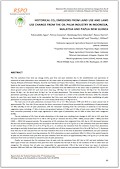| Report |
 |
|
| Title | Historical CO2 emissions from land use and land use change from the oil palm industry in Indonesia, Malaysia and Papua New Guinea | | Author | Fahmuddin Agus, Petrus Gunarso, Bambang Heru Sahardjo, Nancy Harris, Meine van Noordwijk and Timothy J. Killeen | | Editor | Timothy J. Killeen and Jeremy Goon | | Year | 2013 | | Institution | Roundtable on Sustainable Palm Oil (RSPO) | | City | Kuala Lumpur, Malaysia | | Number of Pages | 24 | | Call Number | RP0296-13 | | Keywords | Land use change, CO2 emissions, peat oxidation, low-carbon shrubland rehabilitation |
|
| Abstract: |
The CO2 emissions from land use change (LUC), peat fires and peat oxidation due to the establishment and operations of
industrial oil palm plantations were estimated for the major palm oil producing regions of Indonesia (Sumatra, Kalimantan and
Papua), Malaysia (Peninsular Malaysia, Sarawak and Sabah) and Papua New Guinea. Measurements of oil palm expansion were
based on the visual interpretation of Landsat images from 1990, 2000, 2005, and 2009/2010 that produced a 22 x 22 LUC matrix,
which was used in conjunction with emission factors calculated from the differences in the mean value of published reports for
above ground carbon (AGC) for each land cover class (e.g., 189 Mg C ha-1 for undisturbed forest, 104 Mg C ha-1 for disturbed
forest, 30 Mg C ha-1 for shrub land, 36 Mg C ha-1 for oil palm plantations). The emission factor for peat oxidation for oil palm
plantations operating on peat soils (43 Mg CO2 ha-1 yr-1) was based on a review of the scientific literature, while the emission
factors for peat fires were based on the assumption that fires were used historically to clear land when establishing oil palm
plantations in swamp forest (333 Mg CO2 ha-1) and swamp shrub land (110 Mg CO2 ha-1).
The total area of oil palm plantations increased from 3.5 to 13.1 Mha between 1990 and 2010 at a mean annual rate of
approximately 7%. Over this 20 year period, the direct conversion of natural forest preceded the establishment of approximately
3.5 Mha (36.6%) of new oil palm plantations, with the remainder resulting from the conversion of moderate to low biomass
vegetation types, including 1.7 Mha of shrub and grassland habitats (17.6%) and 3.5 Mha of land cover types (37.5%) that had
been converted previously to field crops, agroforest or other types of plantations, and 0.9 Mha of other land cover categories
(9.5%).
The net emissions of CO2 from oil palm plantations in the study area resulting from changes in AGC due to LUC, peat fires
and peat oxidation increased from 92 to 106 to 184 Tg CO2 yr-1 between the first (1990 – 2000), second (2001 – 2005) and third
(2006 – 2009/10) temporal periods. The proportion of CO2 emissions that originated from AGC due to LUC decreased between
the first and second temporal period, but increased in the third (55 to 42 to 67 Tg CO2 yr-1); the emissions from peat fires linked
to LUC tracked those of AGC (12 to 8 to 29 Tg CO2 yr-1). In contrast, the emissions from the oxidation of peat from plantations
operating on partially drained peat soils increased steadily over all three temporal periods (26 to 56 to 88 Tg CO2 yr-1). Emissions
from AGC due to LUC and peat fires are one time emissions that occur at the time of plantation establishment, but peat oxidation
results in long-term, annual recurring emissions. By 2010, plantations on peat constituted 18% (2.4 Mha) of the spatial footprint
of palm oil, but emission from peat fires and peat oxidation were the source of approximately 64% (118 Tg CO2 yr-1) of the total
emissions from land use linked to industrial scale oil palm plantations.
Finally, we compared the CO2 emissions from oil palm with the emissions from AGC due to LUC and peat oxidation from
other types of land use; emissions from peat fires were excluded due the lack of data on the incidence of fire in other land use
categories. We estimate that oil palm was responsible for approximately 13% of the total of these two types of emissions
between 2000 and 2005 and 18% between 2006 and 2009/2010, based on total estimated emissions of 698 and 792 Tg CO2 yr-1, respectively. The largest source of CO2 emissions originated from a land use trajectory that caused undisturbed forest to be
degraded to disturbed forest and then to shrub land, presumably the result of logging and wildfire. Emissions from AGC from this
type of forest loss and degradation was estimated at 267 Tg CO2 yr-1 between 2000 and 2005 (39% of the total) and 285 Tg CO2
yr-1 between 2006 and 2009/2010 (36% of the total). The sources of uncertainty in this and other published studies are
discussed and represent a potential range that is an order of magnitude smaller or greater than the modeled estimates presented
in this study. Prioritizing the use of shrub and grassland on mineral soil and avoiding of the use of peat soils will reduce emission
significantly, as will enforcing the ban on fire for land clearing. |
|